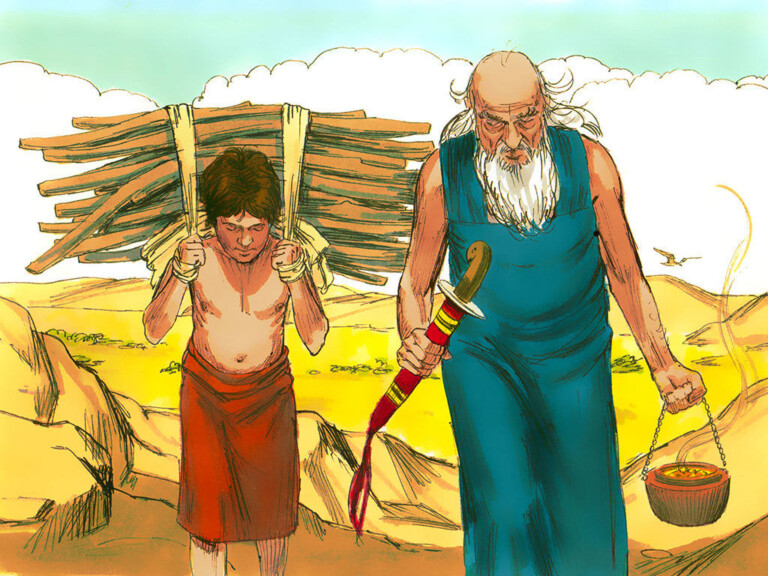Family Devotions – Ideas for What to Do

The Why
There is a reason to have family devotions. If you haven’t read the prior post, click on this link to read about the Why and the How of Family Devotions.
Excuses, excuses, excuses
One reason parents don’t have family devotions is because they think they don’t know how to do this. Some parents think their ideas are not good ideas. Others have never seen this modeled in their own homes. Some parents never enjoyed devotions as a family because of the way it was done. Sadly, some parents think they just don’t have time. There is no better place to start than here and now.
Getting started
Remember that there is no right or wrong way to have family devotions. What works for one family might not work for yours. Consider the ages of your children and their past experience and knowledge of the Bible. Remember that you don’t have to expound on chapters of the Bible each time. Sometimes a few verses discussed in detail will fit the bill. Evaluate what you want to accomplish and then find a way to do it. If one plan doesn’t bring applause from your kiddos, you might want to try something different. Before you get started, remember three things.
- Keep it simple
- Make it easy to implement
- Make it have a lasting – and eternal – effect
We had some ideas and we learned to tweak them along the way as our family expanded. As our children grew older, we had to step up our game! Oh, did we ever! You can do it, too. These ideas you are about to read are just that: ideas. I hope they will be a catalyst for you as you begin or continue your family devotional time. The way we did it might not work for you. Maybe some of our ideas will resound with you. Take our ideas and make yours even better! Find what works for your family; and (most importantly), follow through.
Our Beginning
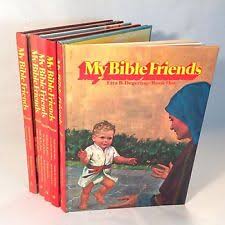 When our oldest was 18 months old, we sat with him on his toddler bed and sang a few songs with motions that he could help do. Rolled Away, Building up the Temple, and Running Over quickly became favorites of his. A few weeks later, we starting reading from My Bible Friends. This is a five-book series with twenty-two Bible stories and wonderful pictures. By the time you complete the books, they are ready to hear the stories again. I’m pretty sure these books were the mainstay of our devotions for the first few years (so much so that our oldest – who was turning three – begged to name child number three Priest Eli because the story of Samuel was his favorite!)
When our oldest was 18 months old, we sat with him on his toddler bed and sang a few songs with motions that he could help do. Rolled Away, Building up the Temple, and Running Over quickly became favorites of his. A few weeks later, we starting reading from My Bible Friends. This is a five-book series with twenty-two Bible stories and wonderful pictures. By the time you complete the books, they are ready to hear the stories again. I’m pretty sure these books were the mainstay of our devotions for the first few years (so much so that our oldest – who was turning three – begged to name child number three Priest Eli because the story of Samuel was his favorite!)
 Another book we used was Beautiful Bible Stories. This one is geared for older children and has less photos and more words. There are questions at the end of each story, and the stories go from Genesis through Acts.
Another book we used was Beautiful Bible Stories. This one is geared for older children and has less photos and more words. There are questions at the end of each story, and the stories go from Genesis through Acts.
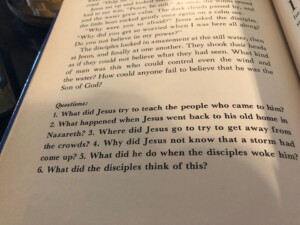
Seasonal Switch Ups

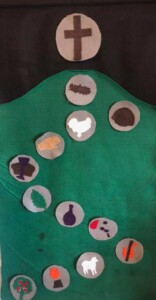
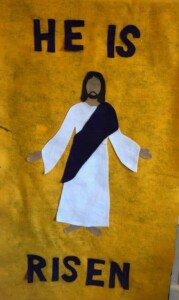

Other devotions you can use at Easter is the Easter story told with twelve Resurrection eggs. I ordered ours from Amazon years ago. Many little fingers have handled this set of eggs. It continues to be used in our home with foster children or in kid’s classes on Wednesday evening at church.
Various phases
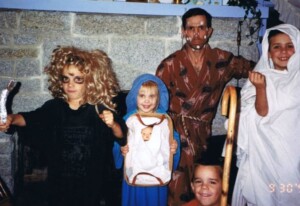
During Halloween season, we had Heroes of Faith night as an alternative to trick-or-treating. Each child came to dinner dressed like a “hero” from the Bible. During supper we guessed each character and talked about what made this person a “hero”. It’s a great catalyst to talk about the obedience to God that put this person into the Hebrews Hall of Fame.

There are many books you can use to incorporate scripture as you read the book. One book we used was The Treasure Tree. This book explains different personalities in a unique way. There is a scripture verse to go with each of the chapters, but you can incorporate more than are mentioned here. If your children experience a lot of rivalry and personality clashes, this book will help them understand each other – and probably help them understand you (and you them). The first time we used this book, our five children were ages 6 months to 6 years. Our oldest two listened to the story and identified their own personality as well as that of their parents and siblings (minus the baby, of course). This book contains six chapters and has a personality check-list at the end. I recommend this type of devotional when you’re traveling or on vacation and spending a lot of time together as a family. Using Psalm 139 along with this book is an excellent way for our children to understand how uniquely each of us is made.
Growing Older
As our children get older, they need to be challenged to think for themselves. We found books that helped fit the bill.

One of the series we used was One Year Book of Devotions 4 Kids. Each day’s reading has real-life situations and scripture that helps define answers for the situations.
From time to time, we played a Bible Numbers Game. Dave assigned a number for the following evening, and each child was to come prepared to tell us stories from the Bible with that corresponding number. If the number was “2”, a child might remember that there were two thieves on the crosses next to Jesus; that Lazarus had two sisters, that the boy with the lunch that served 5,000 people had two fishes in his lunch. What a great catalyst for talking about the events in the stories that our children remembered! One of our sons came with obscure stories that he found by searching a concordance!
A treasure hunt is sure to interest your kids. Use Bible verses to send them to find the next clue, then talk about what they mean when you’re all back together. We did not do this often (because planning the treasure route and fixing the clues takes time!), but our kids enjoyed it when we did. If you come up with a treasure hunt, save your clues because you’ll want to use them later, even if you have to change a few of them.
Acting out a story is a great way to get kids involved. They get to practice and share it during the devotional time. Talk about the story – or have a child read it out loud – after the skit is performed. Our kids had fun acting out stories that were hard to guess. One thing you could do is have one parent show up at suppertime in a Bible costume. Keep the kids guessing until it’s time for devotions, and then explain the costume and the story behind it.
Book choices
The Southwestern Company offers many choices of books for families. In addition to Beautiful Bible Stories, we purchased Family Bible Library, a 10-volume set.

Not only did this set get used for our family devotions, it continues to be used for Sunday school and Wednesday evening kids’ classes today. Geared for school age children, it is a wonderful addition to any home because it has extra activities, photos, and historical information to go with each story.
 We invested in and utilized a Heritage Builders set from Focus on the Family. This set consisted of a family night tool chest. It is published by Chariot Victor Publishing. Again, there are many books in this set, so the topics can vary and be used according to the ages of your kids. This set also works well for kids’ clubs.
We invested in and utilized a Heritage Builders set from Focus on the Family. This set consisted of a family night tool chest. It is published by Chariot Victor Publishing. Again, there are many books in this set, so the topics can vary and be used according to the ages of your kids. This set also works well for kids’ clubs.
There was a time Dave read through parts of the Old Testament – stories of Moses and the Exodus, David hiding from Saul, David’s affair with Bathsheba, and other sensational stories. There is so much material there to talk about trusting God, obedience, respecting those in authority, and results of disobedience. The discussions were many, and bedtime was sometimes pushed back to answer their questions. (As the parents, we knew they had ulterior motives in asking questions, but we didn’t let them know that – and chose to take advantage of the situation!)
Another resource we used was Sticky Situations. This book gives a situation with different choices for responses. Our kids enjoyed this book immensely – so much so that they had fun deliberately choosing a response they knew was wrong in order to get their father’s ire up! If you want to deal with ethical issues, this is a good book.
Being Real
There are many more options out there than what we had when our kids were small. With so many choices available, parents have no excuse to have a boring family devotional time. Our kids will be excited if we are.
Having family devotions, just so we can say we do it, is not a good reason. If we don’t flesh out Truth in how we live each day, our kids will see through us. They won’t be interested in spending time having family devotions if we don’t practice what we preach. What is your reason for having family devotions? Make sure it is authentic, because your kids will know if it is not. Make sure it is fun, and your kids won’t dread family devotions.
Leading Family Devotions
It is important that you and your spouse are on the same page about having family devotions. Encourage your spouse to be the leader in this; encourage him to consider the end result instead of the uncomfortableness of now. When your spouse feels uncomfortable leading in this activity, talk about what makes him uncomfortable. List the reasons why it’s difficult to do, and work on ways you can help each other. The dad doesn’t have to be the one who reads the story. An older child can do that, and so can the mom. If your spouse will not lead out in this opportunity, you can still share Bible stories with your children throughout the day. If your kids know that dad is not on board with this and he is only doing this because you are demanding it, they will lose interest. Ask God to give you wisdom as you consider your options.
Structure of Family Devotions
Music. Children retain more if they hear it put to music. Songs will stay with them long after they are gone from home. The message in those songs will always be a part of them. Even if you can’t carry a tune in a bucket, try singing a few songs. Children can take turns choosing a song; if a child plays an instrument, he can play along for a song of two. Mix things up by allowing different children to be the “song chooser” or “song leader” each evening. Learn new songs or introduce old hymns and the meanings behind those words.
Bible. Incorporating a Bible story, memorizing Bible verses together, or talking about current events with application of scripture are all ways to have family devotions. His Word is truth. The Truth sets us free. Instill the Word into your kids! Talk about questions that come up from reading the stories or the scripture – make it pertinent to their lives today.
Prayer. Younger children can be “helped” to pray. When we started having devotions with our 18-month old, Dave’s prayer (as his held his son’s hands in his) was, “Dear God, Thank you for Papa and Mama. Keep me safe while I sleep tonight. In Jesus name, Amen.” Soon our son was chiming in, “Amen!” at the right moment, all on his own. As children get older, they can repeat a prayer, line after line, with another adult or child. Our children need to learn that prayer is simply conversation with God. By having our children hear us pray for them and for situations in their lives, they are learning that God cares and what matters to us matters to Him. Children’s prayers don’t need to meet adult criteria. For weeks, one of our boys prayed, “Dear God, thank You that we had a fun day today. Help us have a fun day tomorrow. In Jesus name, Amen.” In time, he started adding more to his prayer.
Encourage your children to give their own “requests”. We prayed for teachers, for classmates, for the bully nobody liked, and for our kids to be wise as serpents. We prayed about tummy aches and about sick dogs. You want your kids to pray? Then pray with them and for them where they can hear.
The End Result
At the end of the day, one of the best things we can do with our family (when it is possible) is wind down together. Being together for those moments is a great way to make music, share the Bible, and talk to God together as a family. Before we know it, our children will leave home. One of the best ways we can prepare them to leave us is to teach them the Word. They need to know the principles in the Word and the importance of hiding it in their hearts. One of the best ways to do this as a family is to have a set time for family devotions. This investment is one that reaches great dividends and for which you will have no regrets.








